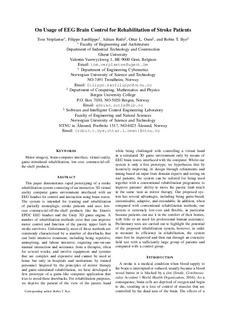| dc.description.abstract | This paper demonstrates rapid prototyping of a stroke rehabilitation system consisting of an interactive 3D virtual reality computer game environment interfaced with an EEG headset for control and interaction using brain waves. The system is intended for training and rehabilitation of partially monoplegic stroke patients and uses low-cost commercial-off-the-shelf products like the Emotiv EPOC EEG headset and the Unity 3D game engine. A number of rehabilitation methods exist that can improve motor control and function of the paretic upper limb in stroke survivors. Unfortunately, most of these methods are commonly characterised by a number of drawbacks that can limit intensive treatment, including being repetitive, uninspiring, and labour intensive; requiring one-on-one manual interaction and assistance from a therapist, often for several weeks; and involve equipment and systems that are complex and expensive and cannot be used at home but only in hospitals and institutions by trained personnel. Inspired by the principles of mirror therapy and game-stimulated rehabilitation, we have developed a first prototype of a game-like computer application that tries to avoid these drawbacks. For rehabilitation purposes, we deprive the patient of the view of the paretic hand while being challenged with controlling a virtual hand in a simulated 3D game environment only by means of EEG brain waves interfaced with the computer. Whilst our system is only a first prototype, we hypothesise that by iteratively improving its design through refinements and tuning based on input from domain experts and testing on real patients, the system can be tailored for being used together with a conventional rehabilitation programme to improve patients’ ability to move the paretic limb much in the same vain as mirror therapy. Our proposed system has several advantages, including being game-based, customisable, adaptive, and extendable. In addition, when compared with conventional rehabilitation methods, our system is extremely low-cost and flexible, in particular because patients can use it in the comfort of their homes, with little or no need for professional human assistance. Preliminary tests are carried out to highlight the potential of the proposed rehabilitation system, however, in order to measure its efficiency in rehabilitation, the system must first be improved and then run through an extensive field test with a sufficiently large group of patients and compared with a control group. | nb_NO |
